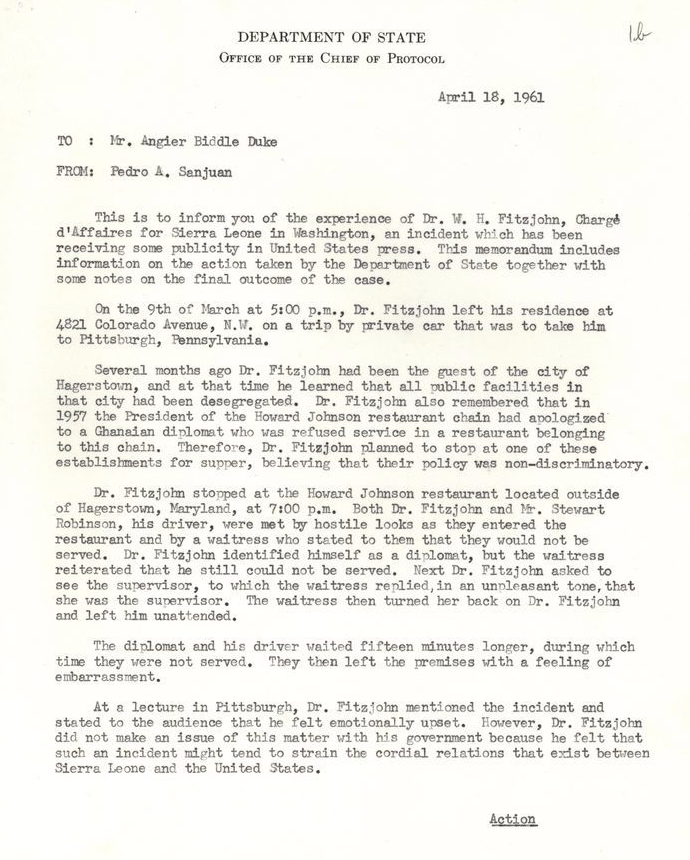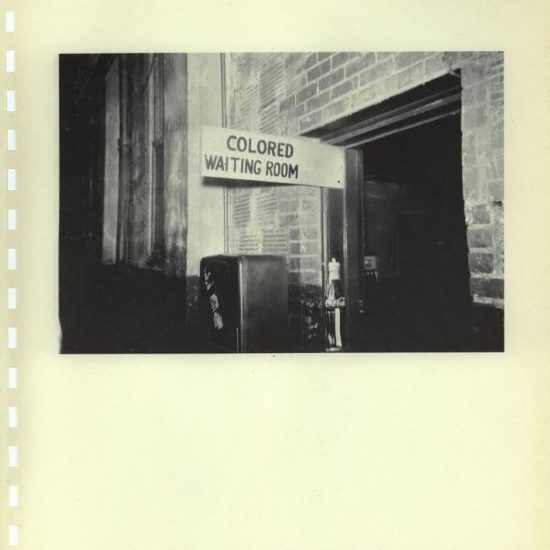By Stacey Flores Chandler, Reference Archivist
We cannot preach the values of democracy if we ignore the struggle for human dignity in our own country.
– Pedro A. Sanjuan, November 1, 1961
Here at the JFK Library, we’re kicking off Hispanic Heritage Month by highlighting some of the fascinating Hispanic and Latinx Americans who appear in our archives, and first up is Pedro Arroyo Sanjuan: a Cuban-born writer, artist, veteran, and civil servant with a knack for languages and a dedication to racial equality.
Though John F. Kennedy’s administration appointed few Hispanics to high-level government positions, Sanjuan was a key figure in the Kennedy-era State Department. Having immigrated to the United States in the 1940s, he worked in Navy intelligence before advising Kennedy’s 1960 Presidential campaign on Latin American policy and outreach to New York’s Puerto Rican communities. He was fluent in nine languages – an expertise that came in handy during his decades of foreign policy work at seven federal agencies and as a Director at the United Nations.
But he’s probably best known for his work after the 1960 campaign, when he was tapped for the Deputy Chief of Protocol spot at the U.S. State Department. His main responsibility was to make sure visits from foreign diplomats went smoothly; it was a detail-heavy and often thankless job, and Sanjuan wasn’t much interested in it when it was first offered (his exact words: “I thought, frankly, that protocol was for the birds.”). But it didn’t take long for him to hear about a problem he wanted to solve, and a collection of Sanjuan’s papers here at the JFK Library help document that focus: fighting race-based discrimination against diplomats of color working in the U.S.
In 1961, many forms of segregation were in place across the country; black Americans were confronted with the practice regularly when trying to travel highways, eat in diners, rent apartments, visit theaters or swimming pools, enroll a child in school, or use restrooms. Signs clearly stating whether a business served “white” or “colored” patrons could be found at rest stops and restaurants along highways – including Route 40 in Maryland, a hub for travel between Washington DC and New York. So when visiting diplomats of color – especially those from African nations – looked for goods and services between their embassies in DC and United Nations headquarters in New York, they often met the same discrimination that black Americans faced.

Though Winifred Armstrong, an adviser in JFK’s Senate office, was investigating this issue in the 1950s, Sanjuan first learned about it from an early 1961 Washington Post article titled “D.C. is a Hardship Post for Negro Diplomats.” In an oral history interview for the JFK Library, Sanjuan said “I was appalled. I thought that something had to be done there.” He explained:
The emphasis on Africa [in the Kennedy administration] was tremendous. …We had to do something about Africa and to win Africa for democracy. …And in the meantime, here we had these countries sending these diplomats to Washington, new diplomats who had never been on a diplomatic mission before. The first thing that happened to them was they were thrown out of a restaurant or they were denied access to an office building; they were insulted. And they got a picture of America that was appalling.
After informing the President (who told him to find a way to “end all this business”), Sanjuan developed a strategy: positioning segregation as a threat to American foreign policy and fighting it from inside the government. He used his position to form committees with state officials and pressure them into getting businesses to serve diplomats of color. “I used to use the President’s name in vain almost every time,” Sanjuan said, explaining that he floated ideas that weren’t specifically cleared by the White House by beginning “President Kennedy thinks…” But his approach met criticism from many angles. Mississippi Governor Ross Barnett replied to Sanjuan’s efforts with this letter to Chief of Protocol Angier Biddle Duke, stating that “the policy of social separation of the races has always prevailed in Mississippi.”

Some of Sanjuan’s fellow State Department employees weren’t impressed, either. Sanjuan ran an all-out publicity campaign to attract press attention to the problem – he said he “really went ahead and made quite a noise” – and his colleagues weren’t sure why he wanted to spotlight an issue that was so embarrassing to the Kennedy administration and the United States. Sanjuan explained his lack of patience for that attitude:
Anybody who was in the Foreign Service and who thought that in the whole world at that time, only a few people knew the well-guarded secret that there was racial discrimination in the United States – that person was beneath contempt for ingenuousness or for hypocrisy. …The blacks are treated badly in this country; this has been known since the days of slavery and before. So now we were supposed to keep this as a well-guarded secret. I used to laugh at them and proceed not to pay much attention to such moronic concepts.
And those weren’t the only objections. Civil rights groups grew frustrated with the government’s willingness to stand up for black foreign officials while black Americans continued to suffer the same mistreatment. Sanjuan agreed “the White House wasn’t doing a heck of a lot on civil rights then,” and also suspected many diplomats “really did not care very much” about racism that targeted Americans. So he decided to use his position “to push civil rights under the door in the guise of foreign policy,” and asserted in his public speeches that “even if you receive these black diplomats like kings and threw black Americans out, you would still insult the Africans.” Just after the first Freedom Rides began, Sanjuan carried this argument to the Kennedy administration, stating in a June 1961 report that diplomats also “resent the argument that they should be treated differently than negro-Americans just for the sake of U.S. prestige in Africa.”


Ultimately, Sanjuan became Director of the Special Protocol Service Section, a new State Department division created specifically to address discrimination. His department recorded over a hundred major incidents of discrimination against visiting diplomats, and implemented solutions to battle segregation everywhere from apartment complexes and schools to barber shops and social clubs – clubs which, Sanjuan pointed out, he wasn’t welcome to join, either.
Though he went on to serve the federal government in global economic policy, nuclear arms control, anti-terrorism strategy, natural resource management, and international law, Sanjuan remained a vocal advocate for civil rights laws and equal employment opportunity, recalling later that “what I was interested in was civil rights, you know. I had only one base of operation, and that was the Department of State, and I was making the best of it.” During Hispanic Heritage Month, we celebrate Sanjuan’s many contributions through his federal service, as well as his lifelong dedication to inclusion and equality for all.
You can learn more about Pedro A. Sanjuan and his work in the State Department by browsing his collection of personal papers and oral history interviews.









[…] Pedro Sanjuan, Insider for Integration […]
[…] prompted the formation of a new unit within the State Department in March 1961. Dubbed the Special Protocol Service Section (SPSS), this newly created entity was spearheaded by Sanjuan, a Cuban-born staffer who had helped […]
[…] prompted the formation of a new unit within the State Department in March 1961. Dubbed the Special Protocol Service Section (SPSS), this newly created entity was spearheaded by Sanjuan, a Cuban-born staffer who had helped […]
[…] Records Documenting Caribbean Immigrants: 1890–1930? (Rediscovering Black History blog)Pedro Sanjuan, Insider for Integration (JFK Library Archives blog)The Panama Canal: Riots, Treaties, Elections, and a little […]